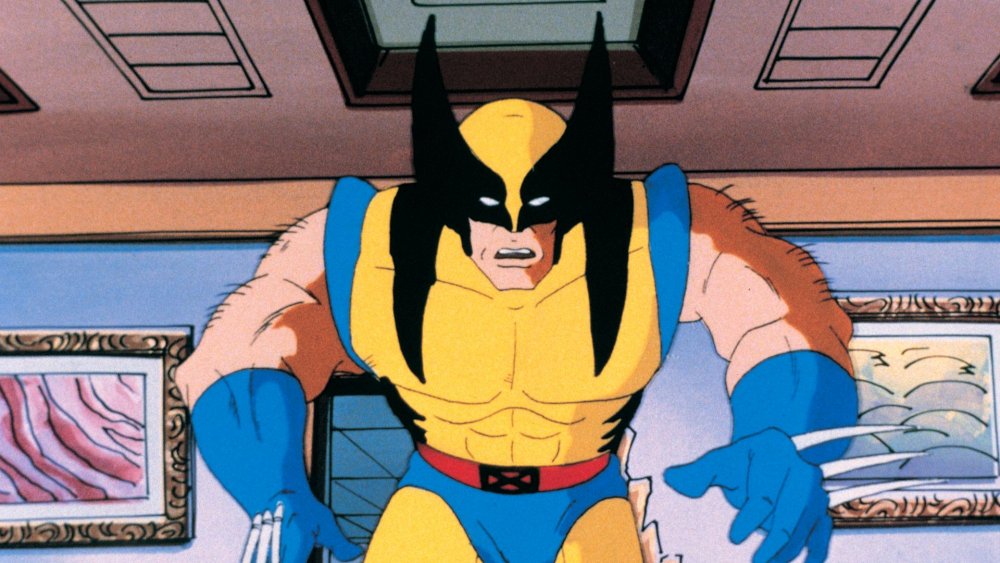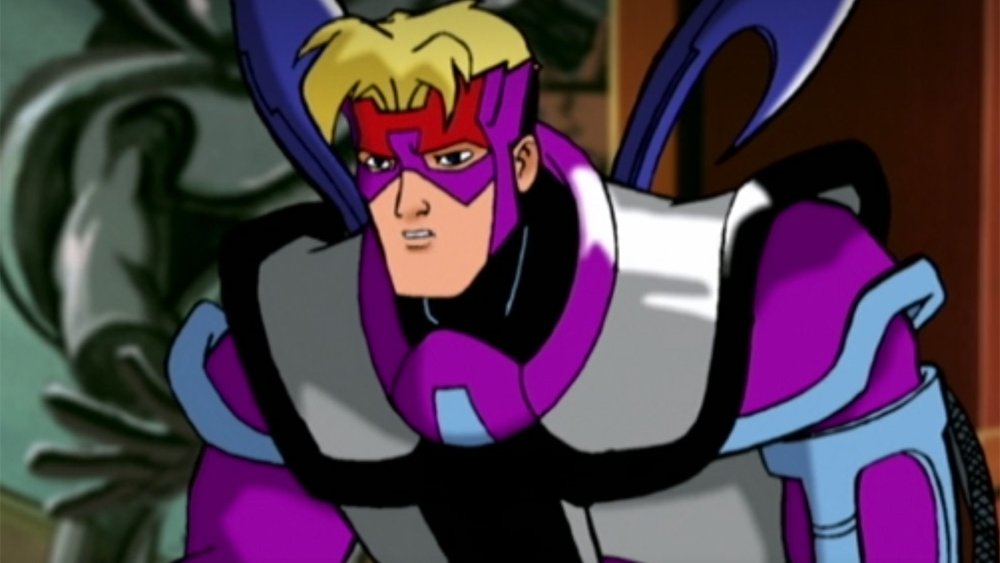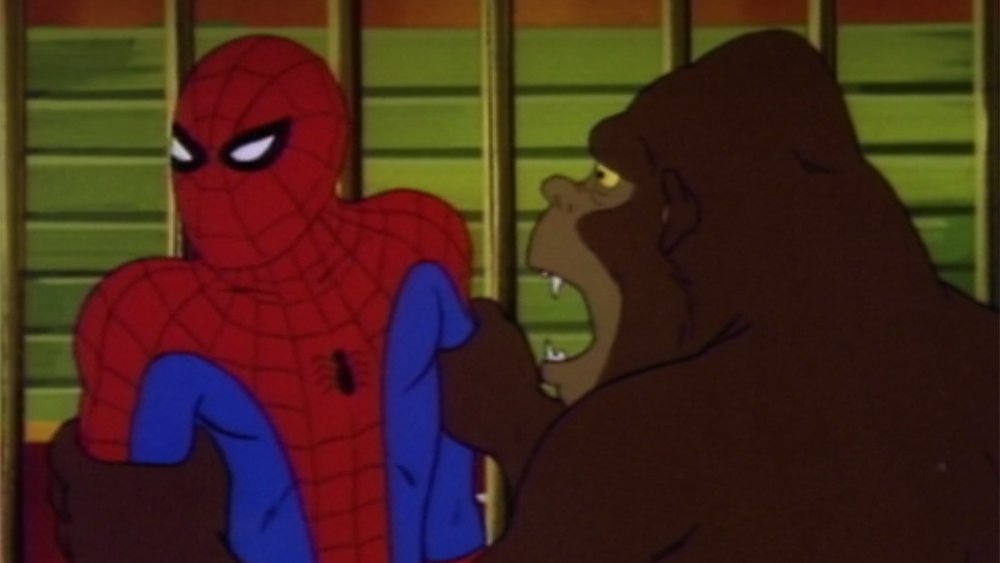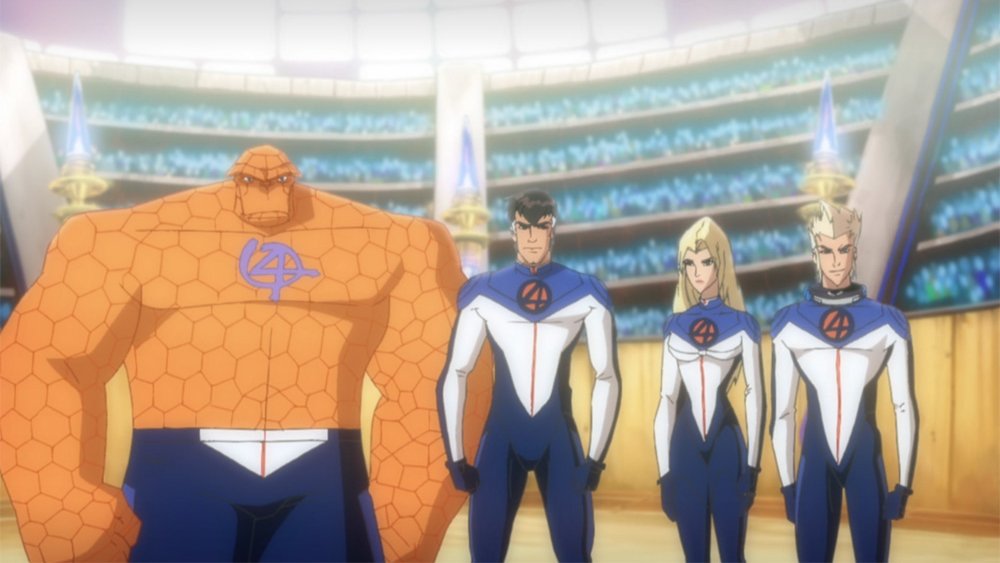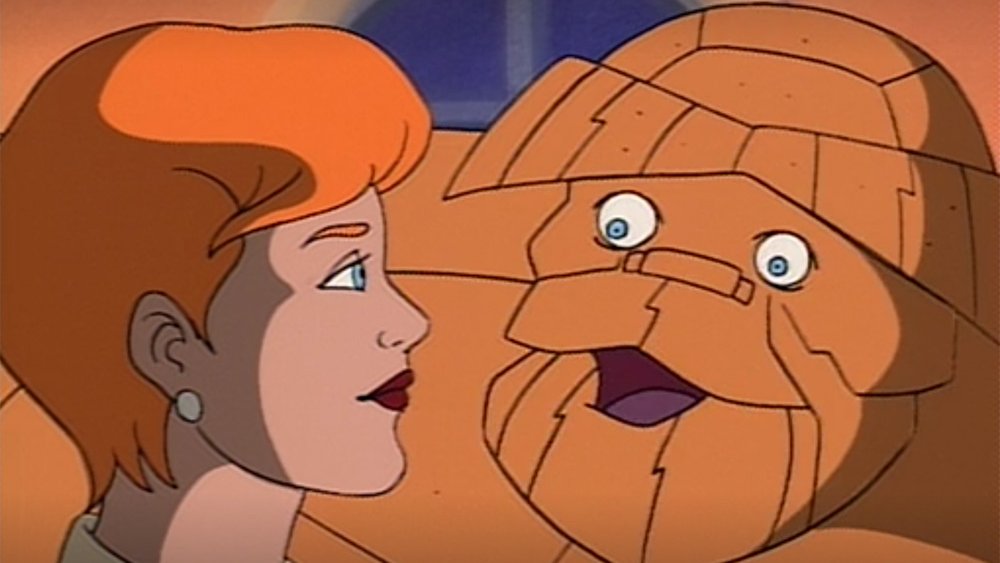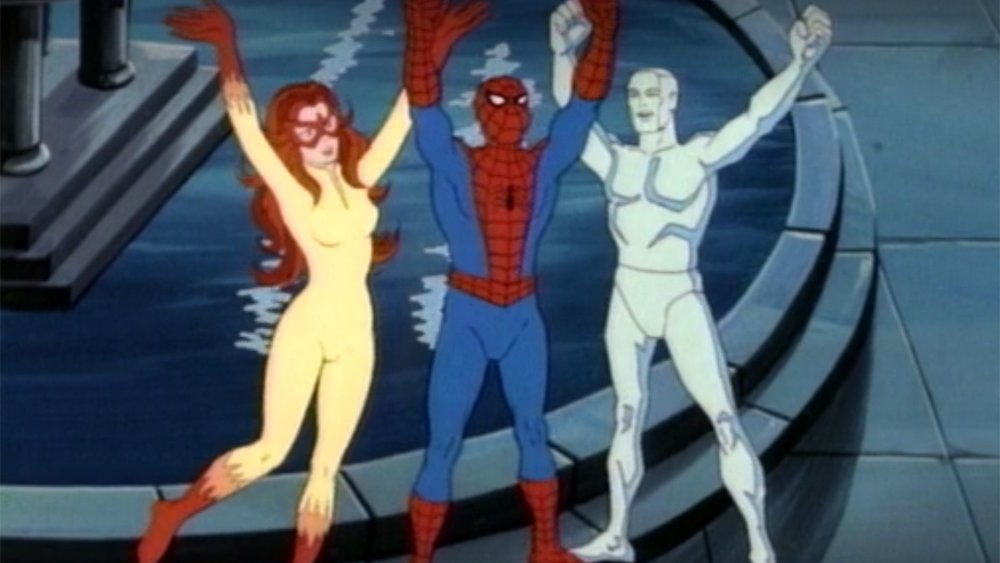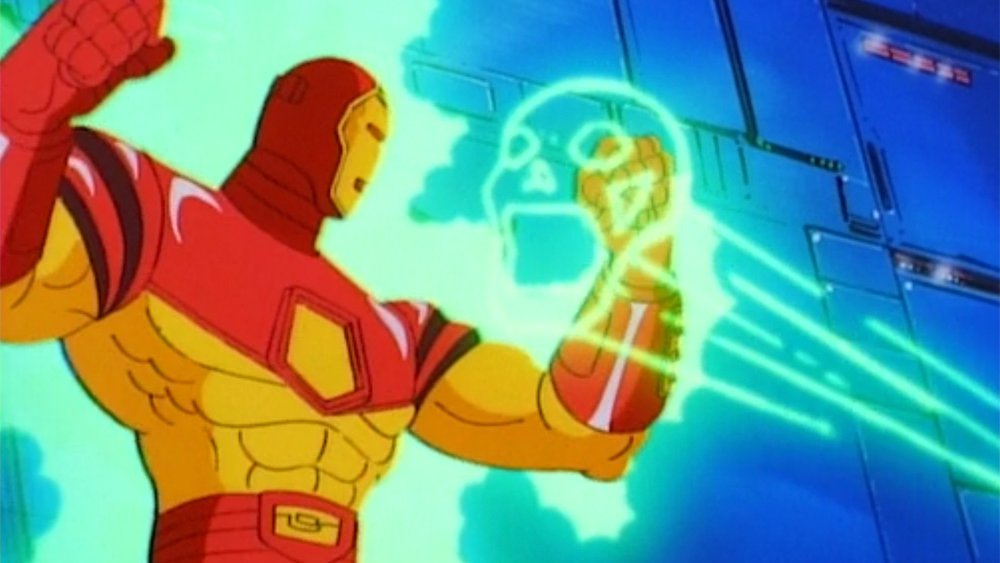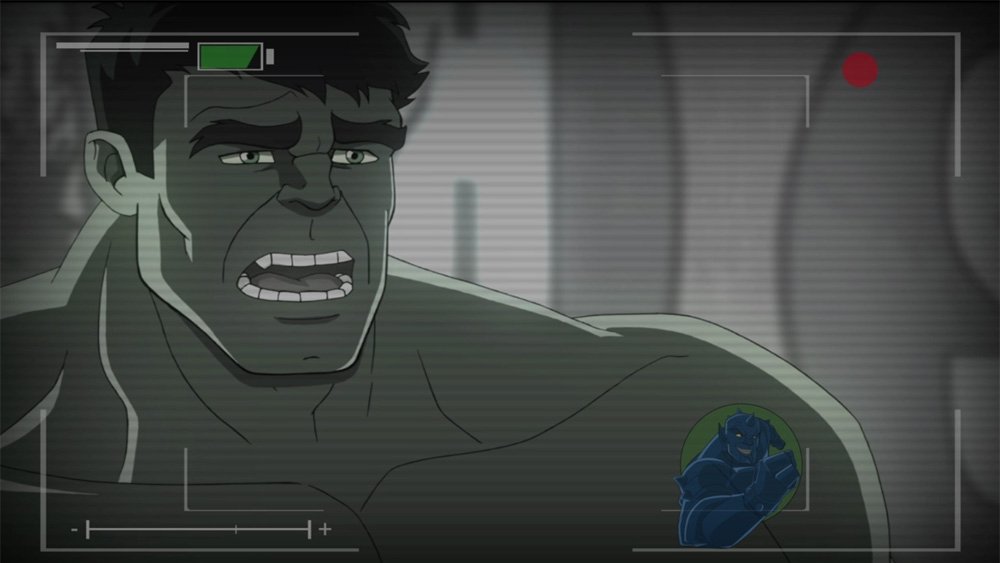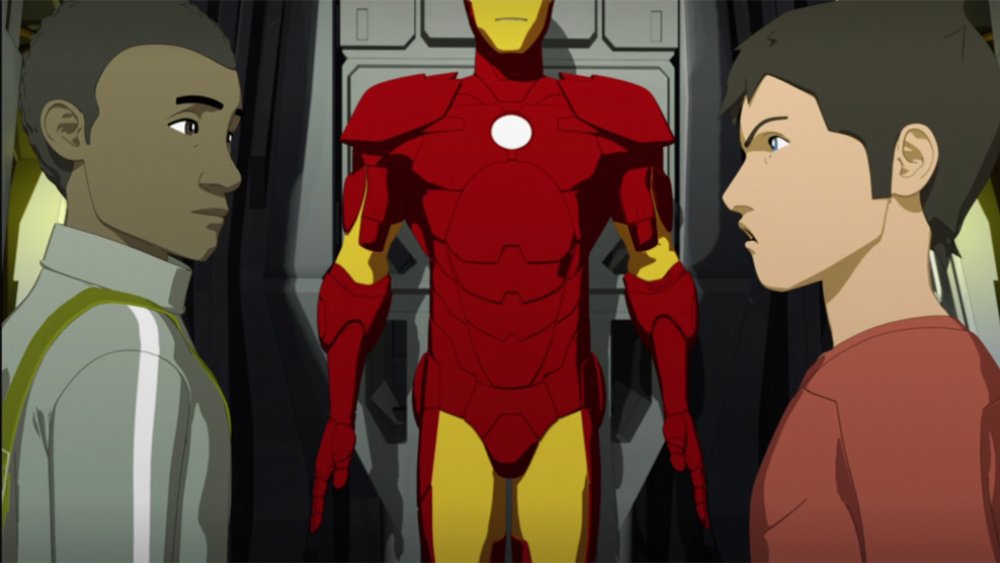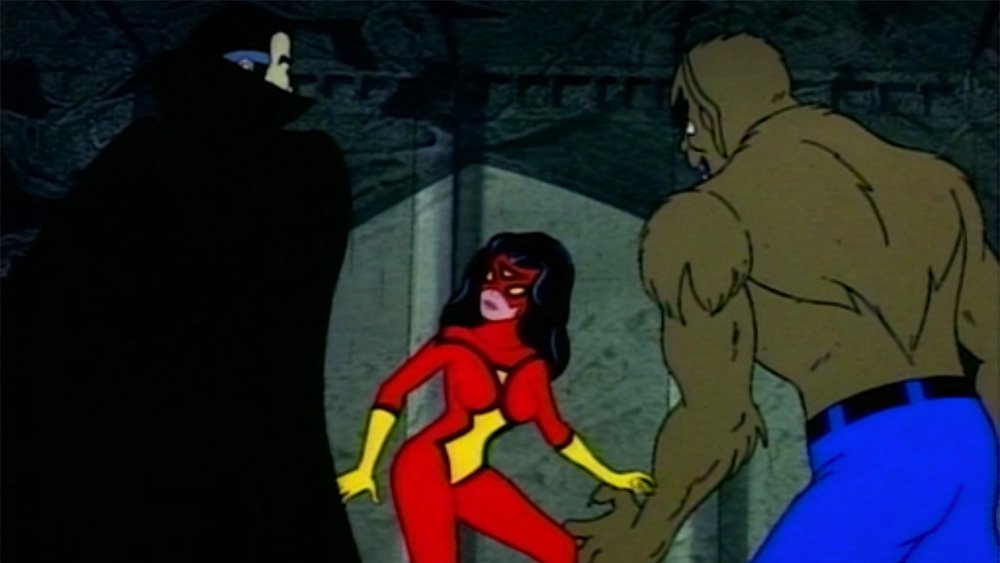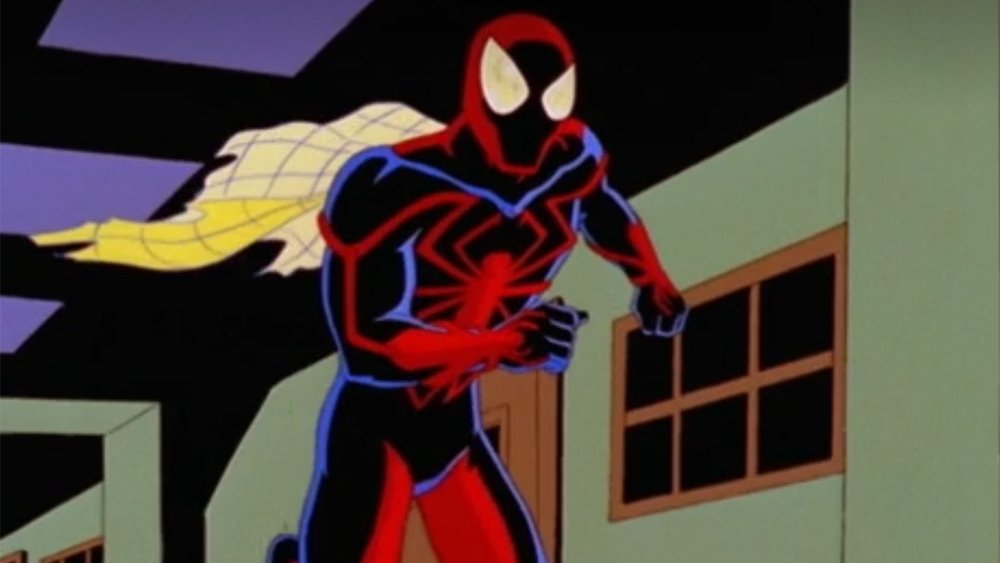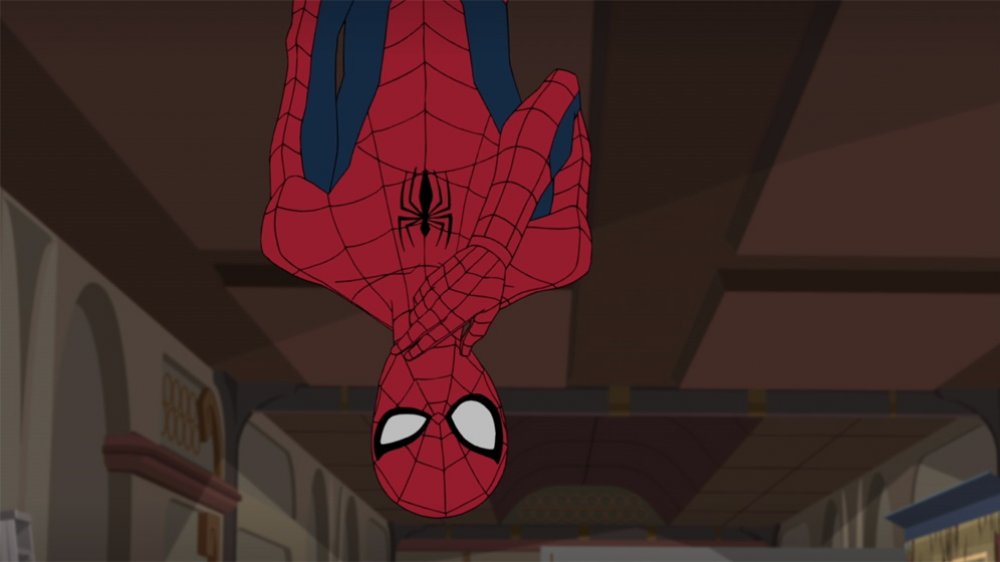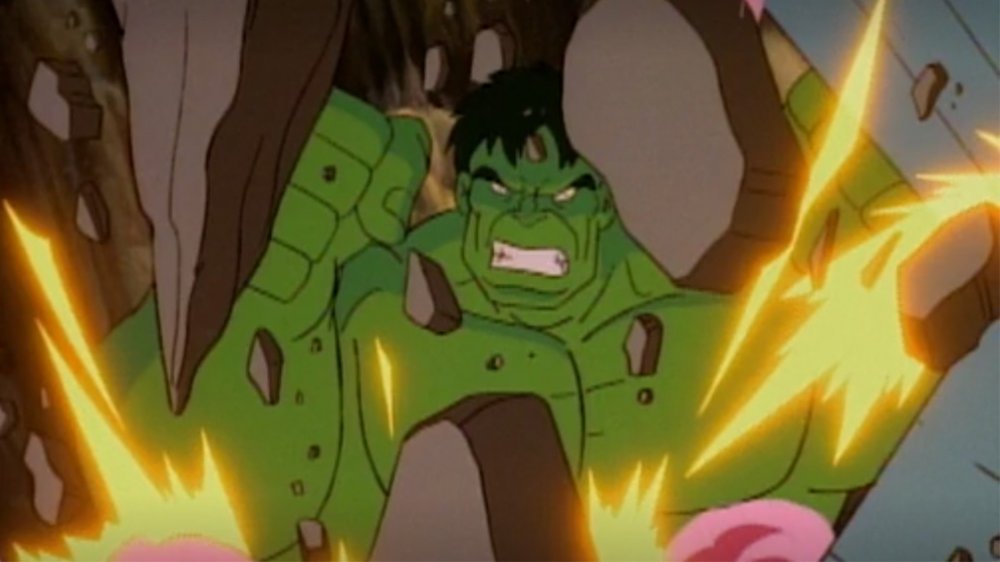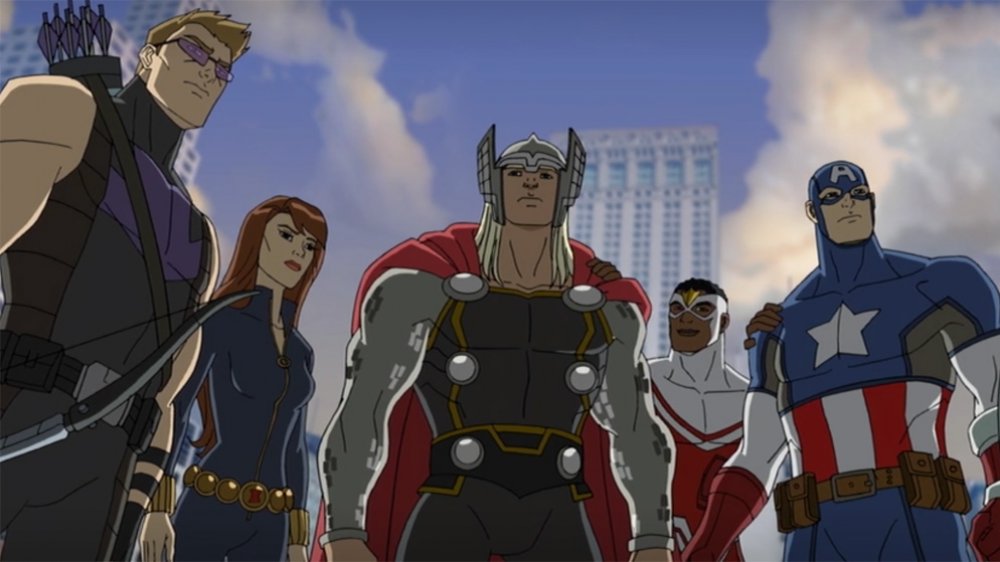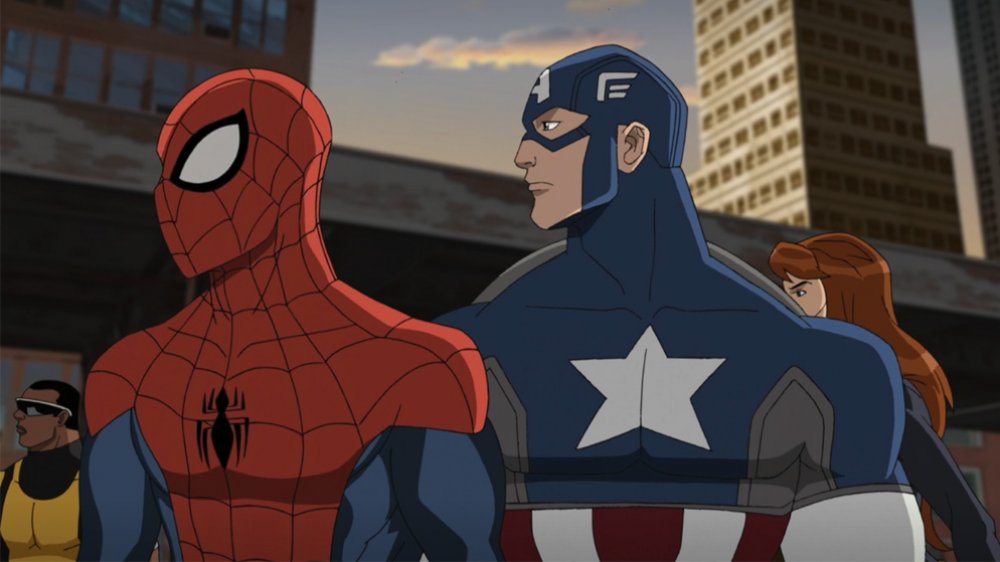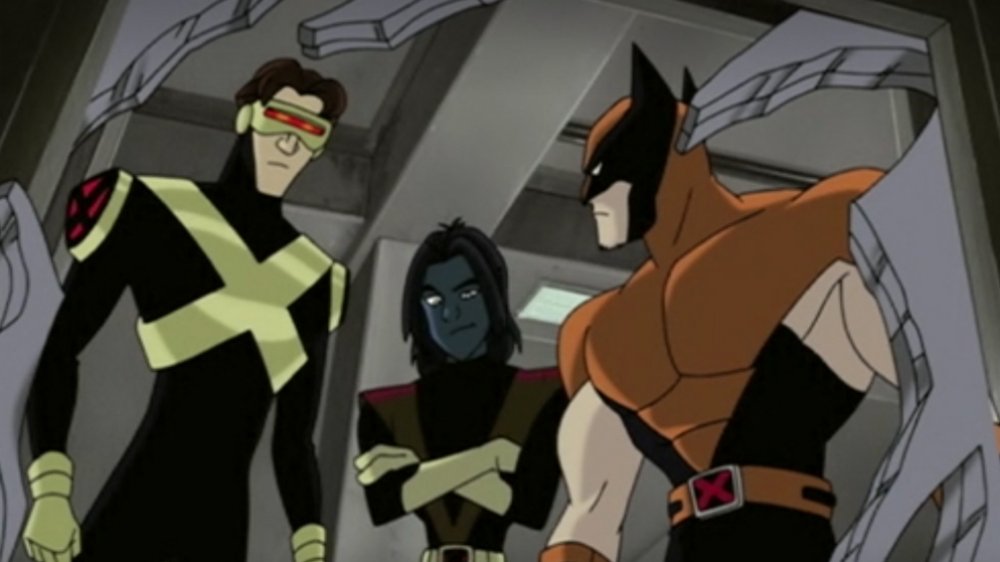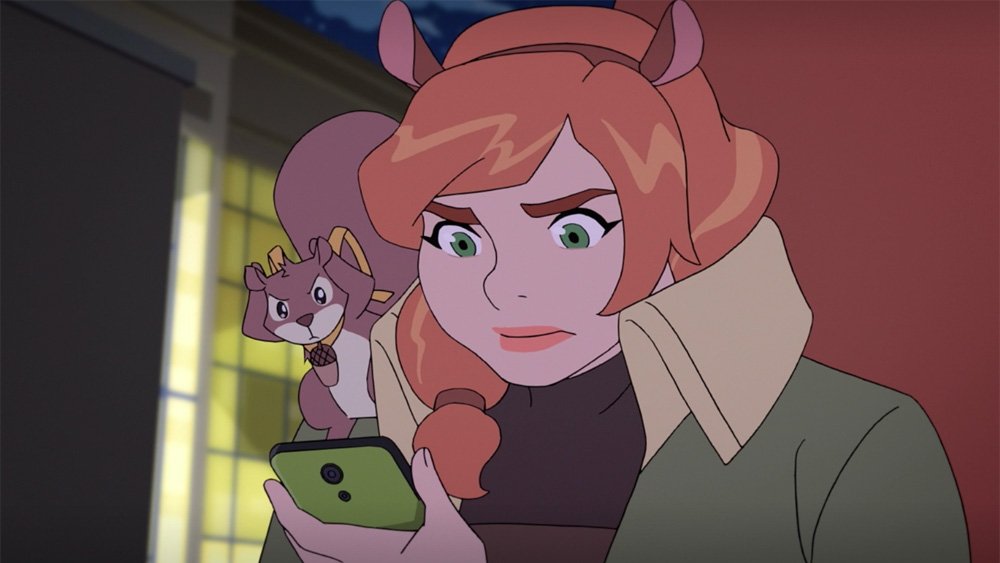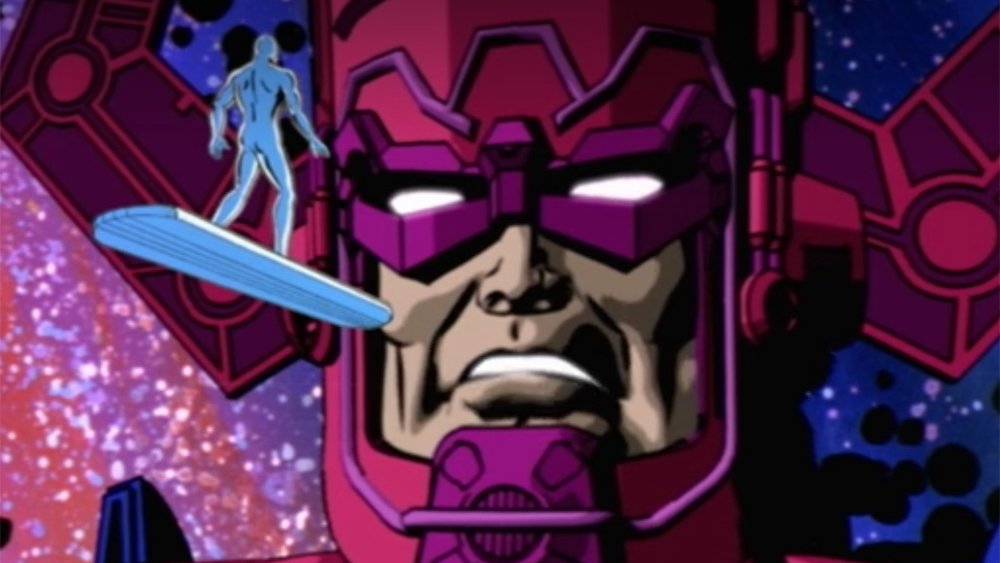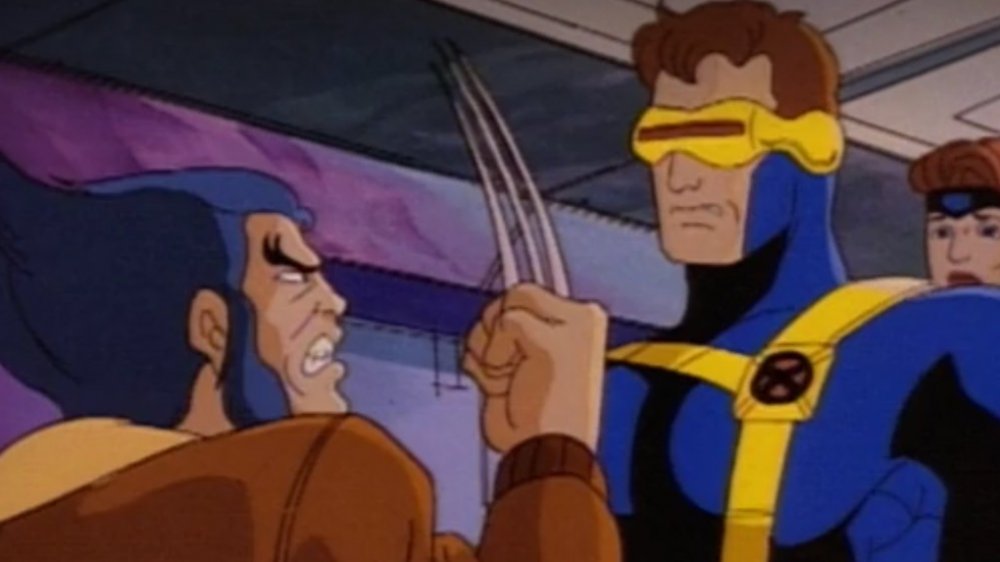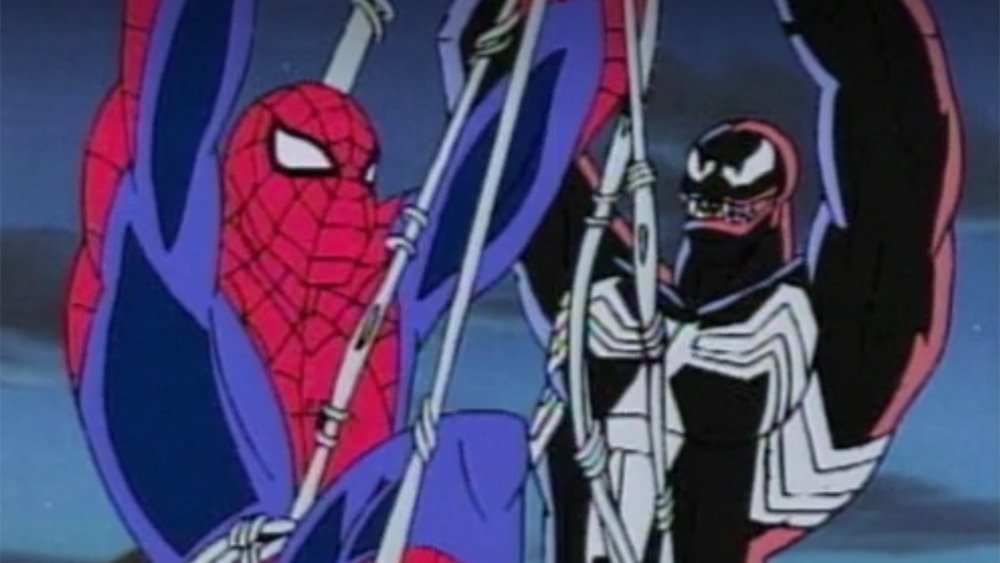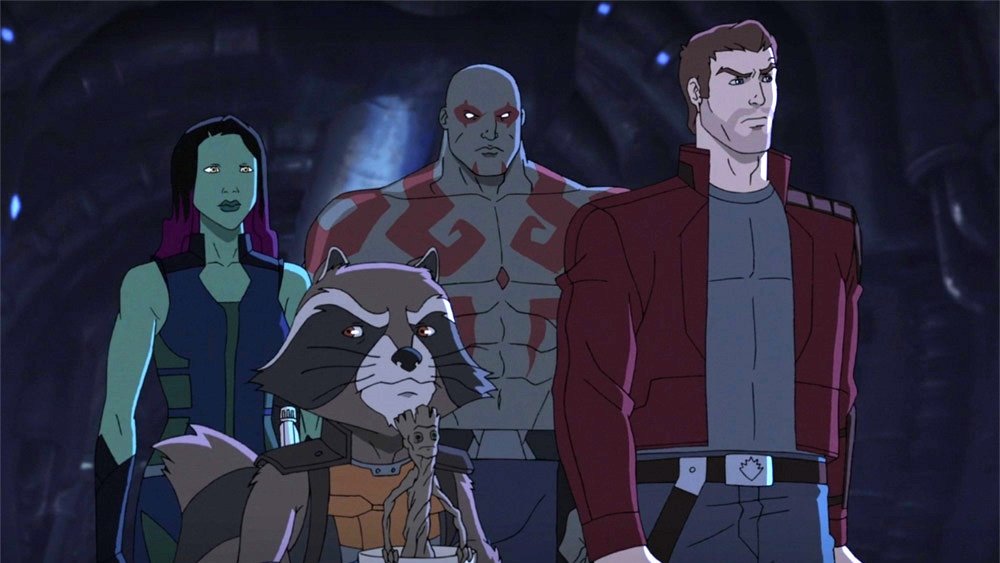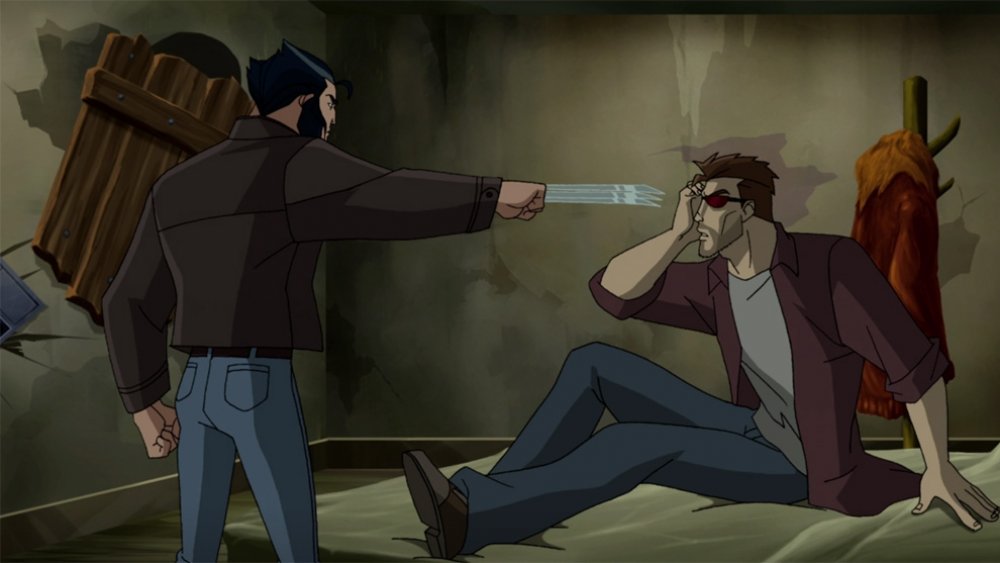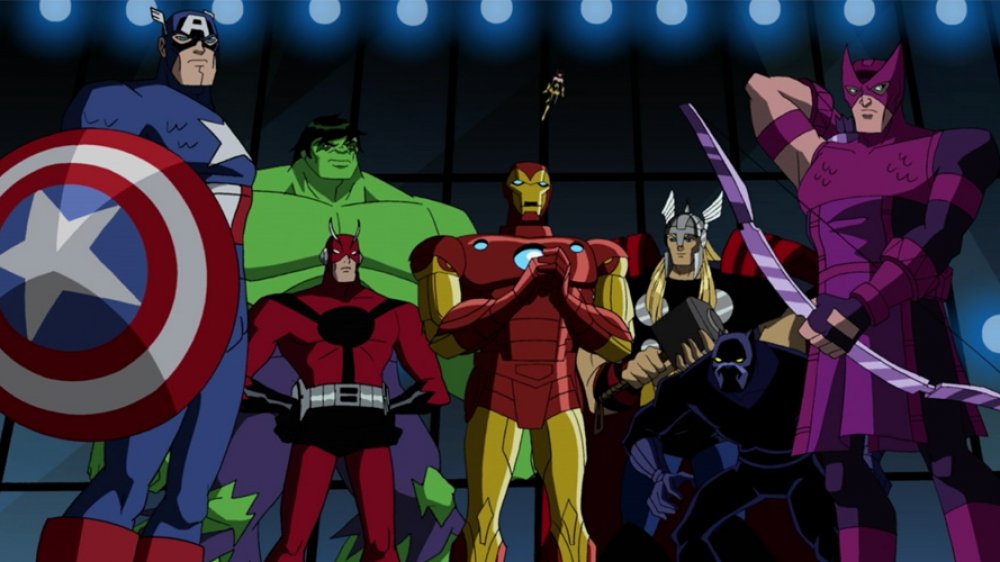Every Marvel Cartoon On Disney+ Ranked Worst To Best
Disney+ launched with a staggering amount of content, but for superhero fans, the real draw came from the surprisingly deep archives of Marvel programming. Sure, having all the MCU films was nice, but we've all seen those a dozen times. Getting the chance to dig through almost every animated series that the House of Ideas has ever produced, though? That's the most exciting thing you can offer an obsessive Marvel fan.
The completists out there are going to watch it all eventually, but for those of you who don't want to sit through 40 years worth of Marvel cartoons, we've done the work for you to determine what's actually worth your time. From the dregs of the Avengers' battle armor to Spider-Man's bizarrely fascinating trip to Counter-Earth and all the adamantium claws you can handle, here's every single Marvel cartoon on Disney+ ranked from worst to best.
Avengers: United They Stand (1999)
The conversation about media these days tend to be based around extremes, and for every piece of media that's hyperbolically declared to be the greatest of all time, there are a dozen TV shows, movies, or video games slapped with a reputation for being the worst ever. If you actually go back and revisit all that media, though, you'll find that a lot of those things, while flawed, don't really deserve their miserable reputations.
And then there's Avengers: United They Stand, a toyetic garbage pile that deserves the bad press it got and the vitriol it would've gotten if anyone had actually watched it.
Canceled about 15 minutes after it debuted in 1999, this one-season wonder has plenty of sins to answer for, but the most perplexing might be the lineup. Rather than doing an Avengers cartoon with big-name characters like Captain America, Thor, and Iron Man — which still would've been a dicey proposition in the years before the MCU made the team a household name — United They Stand gave viewers a team led by Hawkeye and Wonder Man... and yes, those were the big names.
The most infamous aspect, though, came from the redesigns that gave these Avengers hilariously bad "battle armor." This was ostensibly meant to sell toys, which wouldn't be so bad if the toys in question didn't have completely different, yet equally hilariously bad armor of their own. It's bad in a way that's not even fun to watch while goofing on it, but hey: if you're a big Marvel fan looking to question your life choices, this show can make that happen almost instantly.
Spider-Man (1981)
The 1981 Spider-Man cartoon is in a weird sort of limbo when it comes to its place in Spidey's small-screen legacy. It doesn't have the goofy meme potential (or kickass theme song that's still being used today) of the 1967 Spider-Man cartoon, and it doesn't have the high energy and weird complexities of the 1994 show. It's not even the most enjoyable cartoon with the word "Spider-Man" in the title that was on TV in 1981.
None of that really makes it bad (it's fine). but it certainly doesn't help that there are five other Spider-Man shows available on Disney+ right now that are more fun to watch, with three more they could potentially add in the future that, bare minimum, would be a little more interesting. Still, if you've managed to get through every other Spidey cartoon on there and still haven't satisfied your craving, you could do worse than to sit down with the Dr. Doom episodes, or the one where Spider-Man has to fight a rodeo. Then again, if you watch 130 hours of Spider-Man cartoons and still want more, maybe just... try something else? They've got Star Wars on there, that's pretty good.
Fantastic Four: World's Greatest Heroes (2006)
The mid-2000s are a strange, forgotten period for Marvel's non-comics media, with plenty of projects that seemed like they were all just chucked at the nearest wall to see what would stick. Eventually, in 2008, one of those things would stick so well that it would blossom into a billion-dollar film franchise, but the years right before that have a lot of stuff that, in retrospect, just seems weird.
The weirdest (and worst) of the bunch was Fantastic Four: World's Greatest Heroes, an extremely millennial take on Marvel's first family from the French animation studio best known for Code Lyoko that's most notable for its character designs, and not in a good way. Shaking things up with a trendier style seems like a good idea in theory, but in practice, it mostly just looks like the FF as designed by a talented child who just got really into Naruto. Well, three of them look like that, anyway. The Thing is pretty standard, except that he's wearing relaxed fit superhero JNCOs and has spray-painted a big "4" on his chest instead of wearing a shirt.
When it originally aired, it suffered from one of the inexplicable decisions that Cartoon Network makes every now and then to just air a show with a built-in audience at random times so that nobody ever sees it (see also: Beware the Batman), which partially led to its failure. That said, having it all together doesn't do the show a lot of favors.
Fantastic Four (1994)
You probably already know this, but the '90s X-Men cartoon was, to put it mildly, massively popular. It was so huge, in fact, that two years after it came out, there was a cartoon devoted to almost every other corner of the Marvel Universe, too, with what you could very accurately describe as varying degrees of success.
The most variable: 1994's Fantastic Four. As one half of the Marvel Action Hour, a block with Iron Man that was hosted by Stan Lee, the show was devoted largely to pretty strict adaptations of the Lee/Kirby classics that formed the foundation of the Marvel Universe in the '60s, and featured guest appearances from Daredevil, Black Panther, and more. Unfortunately, having some of the best source material in comics to work with didn't mean that the show itself was actually very good. Unlike its contemporaries, it feels like a throwback, with plots and voice acting that seem like they're straight out of the early '80s and Masters of the Universe — a show that was itself partly inspired by Kirby's work.
If it had aired ten years earlier, FF '94 would've blown everything else away, but in the mid-'90s, well, even the people at Marvel Comics didn't like it. In Fantastic Four #396, from January of 1995, Tom DeFalco and Paul Ryan gave comics readers a scene in which Ant-Man watched an episode of the "crummy" new FF cartoon and told the Thing "forget about being attacked by your old super-villains — you'll be destroyed by the ratings!" Ouch.
Spider-Man and His Amazing Friends (1981)
And here we have the the show that actually was the most enjoyable cartoon with the word "Spider-Man" in the title that was on TV in 1981.
Objectively speaking, Spider-Man and His Amazing Friends is virtually the exact same quality level as Spider-Man '81, but this one gets the edge for a couple of reasons. For one thing, Spider-Man has always worked really well in the context of having other characters to hang out with — there's a reason that he was the star of Marvel Team-Up for 150 issues, after all — and having Firestar and Iceman around is a little more interesting than having him talk to himself.
The other reason is that SMAHAF has some completely bonkers guest stars from across the Marvel Universe. Disney+ doesn't include the episode where Hitler shows up (for what are probably obvious reasons), but it does feature the ones with with Dracula and the X-Men, long before they'd get their own show, and those are pretty fun.
Iron Man (1994)
It might be difficult to believe when you're looking back from an era when Tony Stark was essentially the main character in a franchise that spread across 23 blockbuster films, but back in the '90s, calling Iron Man a cornerstone of Marvel's B-list would've been pretty charitable. With that in mind, it might be a little surprising that he was the one — and not, say, Thor or Captain America — who got to join Spider-Man, the X-Men, and the Fantastic Four on TV. Then again, there has never been a superhero who was easier to slide right into a toy line built around highly specific suits of armor, and since selling toys was what this show was pretty clearly meant to do, maybe it's not that much of a shocker.
It's easy to assume that a sprawling action figure line was also the reason this show had such a huge cast. TV Tony was joined by an entire team based on a seldom-remembered comic book spinoff called Force Works, including War Machine, Spider-Woman, Hawkeye, the Scarlet Witch, and Century, who might hold the distinction of being the most obscure Marvel character to ever have a major role on a TV show. Regardless of the intent, the result was a show that might not be great, but is enjoyably weird. Seriously, this is a cartoon where one of the major recurring villains is MODOK, the Mental Organism Designed Only for Killing, who at one point is pushed around in a baby carriage as part of a disguise. Great? No. Worth watching? Absolutely.
It's also worth noting that Iron Man had a pretty incredible roster of voice acting talent. MODOK was played by Jim Cummings, likely best known as Winnie the Pooh, Spider-Woman was played in the second season by Mass Effect's Commander Shepard herself, Jennifer Hale, and James Avery added War Machine to his acting resume right next to Shredder and Uncle Phil from The Fresh Prince of Bel-Air.
Hulk and the Agents of S.M.A.S.H. (2013)
Agents of S.M.A.S.H. should've been great. It was developed by Paul Dini, of Batman: The Animated Series fame, had an incredible roster of voice talent that included Seth Green, Clancy Brown, and Eliza Dushku, and had one of the most clever premises you could ask for. Operating under the assumption that if one Hulk was incredible, five would be unstoppable, the Supreme Military Agency of Super-Humans (get it?) put Bruce Banner's big green alter ego in charge of a strike force made up entirely of his fellow gamma-powered heroes. Together, they battle the forces of evil, all while Rick Jones is filming everything for a reality show, which of course results in cutaways to confessional-style shots where the cast talks directly to the viewer.
In other words, it's The Office or Parks & Recreation, but with the Hulk, and in theory, that sounds great. In practice, though, it's a drag. The jokes fall flat, the action is usually pretty perfunctory, and it turns out that building your show around five people who basically have the same powers and do the same stuff in slightly different ways isn't the best dynamic for a team.
Iron Man: Armored Adventures (2009)
Picture, for a moment, the office of a network executive trying to decide what kind of cartoons they should be putting on TV for the next year. Someone walks in and says "Hey, there's an Iron Man movie coming out, so we should probably do something to capitalize that." The exec says "Iron Man? Is he popular with kids?" and the guy pitching the show nervously tugs his collar and says "Uh, not really, no, because this is 2008." "Fine," says the exec, "we'll do an Iron Man cartoon, but figure out some way to make him more appealing to kids. You have one hour."
We don't know if that was the conversation that led to the creation of Iron Man: Armored Adventures, but we do know that Armored Adventures is exactly the show that would result from it. The big twist to get the kids into it is that instead of being an adult billionaire weapons manufacturer trying to atone for the sins of his past, this Tony Stark is a cool teen! As you may already know, that's an idea that went notoriously bad when they tried it in the comics about a decade earlier, and takes away Tony's entire established character arc while making him a rich kid who literally asks for more homework in the pilot. You know, just what kids like.
Spider-Woman (1979)
Spider-Woman has the distinction of being the oldest Marvel cartoon currently available on Disney+, and for those of you planning on watching your way through the entire Marvel catalog in chronological order, there are worse places to start. It's definitely every bit as clunky as you'd expect from the late '70s, but it also might be the single most buck wild superhero cartoon ever made.
Seriously, this thing starts with an episode with a Spider-Man guest appearance that also finds our heroine fighting a mummy, and just gets weirder from there. Episode 2? She fights Dormammu, the gigantic fire-headed demon from the end of Doctor Strange. Episode 4? Time-traveling vikings. Episode 10? Dracula, Lord of the Vampires, is turning the entire world into Halloween monsters and only Spider-Woman can stop him!
There are definitely better shows to watch on Disney+, but if you're into the goofy stuff, or just want to see how the unfathomable weirdness of the Bronze Age Marvel Universe was translated directly to television, there aren't many that are going to be more fun than this one.
Spider-Man Unlimited (1999)
All right, first things first: Spider-Man Unlimited is not a "good" show in the traditional sense. It's actually pretty bad in most respects, including some janky animation, subpar costume designs, and a premise that throws out most of the things people actually like about Spider-Man. It is also a fascinatingly bizarre piece of Spider-Man history that nobody ever really talks about, and you should absolutely watch it, at least for a few episodes.
The whole thing happened because Saban wasn't allowed to use any of the traditional Spider-Man origin stuff for their new show, since the Sam Raimi Spider-Man movie was already in production and Marvel didn't want to saturate the market on radioactive spiders and dead Uncles Ben. With that in mind, they instead went with a series that was a kinda-sorta-not-really sequel to the recently ended '94 Spidey cartoon, but with a sci-fi twist. See if you can follow this beautiful madness: When astronaut werewolf John Jameson's space shuttle gets a few unexpected stowaways, Peter Parker winds up chasing Venom and Carnage to a parallel Earth full of human/animal hybrids created by the High Evolutionary. To give him an edge on this strange Newer York, he steals a high-tech suit made of nano-machines that give him a Sailor Moon-style transformation sequence, and joins an underground resistance to free humanity from the domination of the animal hybrids.
It is completely bananas, and probably won't surprise you to learn that it was canceled, with good reason, after a single 13-episode season. If you go into it expecting less of a good show and more of an overwhelmingly strange take on Spider-Man, however, you'll at least have some fun with how unbelievably weird it is.
Spider-Man (2017)
Spider-Man 2017 sure is a cartoon about Spider-Man. It definitely has Spider-Man in it, and it's a cartoon. Yes, that's exactly what it is, all right.
Okay, maybe that's a little harsh. The show's not at all bad, especially when it brings in characters like Miles Morales and Gwen Stacy. If nothing else, sticking a little closer to the traditional Spidey setup means that it doesn't have the slightly dubious premise of making Spider-Man a military-trained super-cop who operates outside the law that we got in its predecessor, Ultimate Spider-Man. The flip side to that, though, is that it also doesn't really have anything to distinguish it. The quality is certainly there, but without some way of distinguishing it from the other Spider-Man stuff out there, it just isn't all that memorable on its own.
Incredible Hulk (1996)
If you're going to watch any of the Marvel cartoons that came out following the success of X-Men, it should almost certainly be Incredible Hulk. Just make sure you stop after the first 13 episodes.
More than any of the other Marvel shows, Hulk succeeds in the same way that X-Men did. Rather than stripping things back and simplifying them for its younger audience, it dove (gigantic green) headfirst into the more complicated parts of the Hulk's continuity that made him so compelling to readers. The multiple Hulks lurking in Bruce Banner's psyche, the enmity that Banner felt for his alter ego, and Thunderbolt Ross' insane, Ahab-esque pursuit of the Hulk were all elements of the show. It was also much darker and more violent than its contemporaries, something that producer Dick Sebast chalked up to the Hulk's monstrous power requiring the show to pit him against equally powerful monsters or giant robots, something network censors were a lot more tolerant of than violence against normal, non-irradiated humans.
And then came season 2, and a shift in creators demanded by network execs that, according to Sebast, "had no feeling for what the Hulk was about or what was most important to an action-adventure show in general, or to Marvel fans in particular." He's not wrong. It's a shame, given how good the first season is — especially by 1996 standards — but the dramatic drop in quality makes a full half of the series a pretty tough watch.
Avengers Assemble (2013)
Developed by Man of Action Entertainment — a group of comic book writers turned animation moguls who are probably best known for creating Ben 10 — Avengers Assemble is another show that was pretty clearly released to capitalize on a movie. No prizes for guessing which one.
Unlike other shows, which either hewed too close to their cinematic inspirations or ditched too much of what makes the characters work in favor of mass appeal, however, Assemble did something really interesting with its premise. The show opens with the Avengers having already broken up, and a depressed Tony Stark trying to get the team back together — mainly because he doesn't have any other friends — for a mission that goes disastrously wrong. The Red Skull winds up stealing Iron Man's armor and forming his own super-team, challenging Earth's Mightiest Heroes with an equally powerful gang of the world's worst villains, including Dr. Doom and Dracula.
The show did a lot with the idea of a cast who had to set aside their personality clashes to deal with these truly overwhelming threats, and drew inspiration from classic stories like "Under Siege" — uh, the one where the Masters of Evil destroy Avengers Mansion, not the Steven Seagal movie about the cook who's actually a Navy SEAL. It kept building to bigger threats in every season, and gave fans of the cinematic Avengers a team they could recognize without feeling like it was just repeating the same ground.
Ultimate Spider-Man (2012)
There are a lot of Spider-Man cartoons out there, which makes it tough for a new one to figure out an angle that hasn't been done before. Ultimate Spider-Man tried to carve out a niche by doing what the MCU would eventually do and that the comic of the same title had done before: making Peter Parker a sort of hero-in-training working with S.H.I.E.L.D., and eventually giving him his own team of teenage heroes to pal around with. It's a solid idea that leads to some really good stuff, especially in the later seasons where they're pulling in elements like Agent Venom and doing a neat little TV version of Spider-Verse, but it doesn't always stick the landing.
Honestly, your enjoyment of this one is going to depend quite a bit on your tolerance for the cutaway gags and anime-style Chibi-Spidey fourth-wall breaks. If you can find the fun in those, there's a solid Spidey series here that frequently feels like a classic Marvel Team-Up.
X-Men Evolution (2000)
X-Men Evolution had a difficult task. It was caught between the previous X-Men cartoon, which ended in 1997, and the live-action movie from 2000 that was replacing it as pop culture's definitive version of the team. As a result, Evolution had to be something different, and to the show's credit, getting back to the idea of the X-Men as teenagers trying to keep their powers in check while navigating high school had a lot of potential.
Sadly, it never really came together as well as you'd expect, and feels trapped between those two other versions. The X-Men are all teenagers, for instance, except that they apparently need someone to be their RA at the boarding school that they go to while they also go to another school (?), which means we're robbed of getting a show featuring Wolverteen. The show as a whole even undergoes a dramatic tonal shift in its third season, and while it's never really bad, it's definitely inconsistent.
On the bright side, it features solid performances and some genuinely good costume designs. The X-Men having uniforms inspired by the classic New Mutants design leads to some really good stuff, and reimagining Rogue as a sullen Mississippi goth was great.
Marvel Rising (2018)
Marvel Rising doesn't really fit the definition that we've laid out for the rest of this list, since it's not actually a TV show like the others. Instead, it's a series of two-minute shorts and a full-length movie. Average it out, though, and it's close enough to count.
Besides, the format matters less here than the quality, and Marvel Rising has plenty of that. WIth a focus on newer characters like Ms. Marvel and cult favorites like Squirrel Girl and America Chavez, it feels fresh in a way that a sixth Spider-Man show just wouldn't. Plus, it's not afraid to go big; the movie starts out with standard-issue high school heroics and winds up in space with the characters palling around with a teleporting dog. The word that best describes it is "refreshing," and if you're looking for something that's not only good, but also doesn't feel like the same old show and focuses on the heroes who are defining this generation of Marvel Comics, it's the one to watch.
Silver Surfer (1998)
Silver Surfer might be the single most underrated Marvel cartoon of all time. Like the abysmal Avengers: United They Stand, it only ran for 13 episodes, and thanks to its premature cancelation, it's often lumped in with that one in the minds of fans as an experiment in lesser-known characters that just didn't take off. Fortunately, we're here to let you in on a little secret: Silver Surfer rules, actually, and it's well worth your time to go back and check it out. In fact, it was actually a hit, and was only canceled due to what the show runner called "legal differences" between Marvel and the show's producers, Saban.
One of the common complaints about Marvel's animation output is that unlike its Distinguished Competition, which built decades of shows around the Art Deco aesthetic that Bruce Timm designed for Batman: The Animated Series, the Marvel shows don't really have a strong visual identity. Silver Surfer, however, pulled its visual cues straight from the cosmically charged pencil of Jack Kirby, the co-creator of the Marvel Universe, doing a pretty amazing job of capturing the art style that redefined comics in the '60s. There's even an interesting touch in how other characters are presented: Galactus, the Devourer of Worlds, is done as a towering CGI figure that, contrasted with the traditional animation for everyone else, makes him seem like this weird, unknowable force of nature that doesn't belong on the scale of everything else, which is exactly what he's supposed to be. It's rare that a show can turn its limitations (in this case, bad late '90s CGI) into something that makes it better, but Silver Surfer pulls it off.
Plus, it got to a side of the Marvel Universe that was rarely seen in cartoons for a decade in either direction, bringing in spacefaring weirdos like Beta Ray Bill, Drax, Nova, Eternity, and a somewhat obscure cosmic villain named Thanos, who was the show's primary antagonist. Maybe that was one of the factors that led to the show ending. After all, Thanos? Who'd ever want to see more of that guy?
X-Men (1992)
For a certain generation of fans, the '90s X-Men cartoon is probably the most well-remembered Marvel animated series of all time, and it's unquestionably the most influential. With a run that lasted for five seasons of shows that combined classic X-Men stories like the Dark Phoenix Saga with the over-the-top '90s aesthetic inspired by Jim Lee, this series set the tone for the next decade of Marvel animation and hooked countless kids on the superheroic soap opera of the mutant heroes who protected a world that hated and feared them. Also, as every single mention of this show on the internet is contractually obligated to point out, it had a killer theme song.
As much as we all love this show, however, it's far from flawless. For one thing, it's distinctly just... weird. Adapting classic X-Men stories with a different lineup — usually substituting Rogue, Gambit, and Jubilee for Colossus, Nightcrawler, and Kitty Pryde — led to some bizarre plot holes. The show's adherence to strict Standards & Practices rules meant that it's yet another show where nobody could throw a punch, including Wolverine, a guy whose entire deal is that he has super-sharp knives on his fists. Even worse, it suffers by comparison to its contemporaries. X-Men debuted a month after Batman: The Animated Series, on the same network, and while BTAS still looks revolutionary, X-Men seems very much like a product of its time.
So yeah, it's a little bit of a mess, but you know what? That's what makes it so fun to watch. Well, that and the voice acting that, even when it's bad, is somehow even better than good. In a time when the X-Men were on everything from comics that were selling millions of copies to canned pasta, this was the version of the team that defined the era.
Spider-Man (1994)
If X-Men paved the way for the next decade of Marvel cartoons when it launched in 1992, then Spider-Man refined it into its best form when it hit the airwaves two years later. On one hand, it's easy to see how they pulled it off: instead of having to juggle the complicated cast that X-Men brought to the table, Spider-Man could focus on, well, you know. His name's right there in the title.
On the other hand, Spidey was saddled with an even worse comparison problem than his mutant buddies were. As you can tell just from looking at this list, Peter Parker '94 was trying to web-swing his way out of the shadow of plenty of other Spidey cartoons, and the fact that it's still remembered even after all of its successors says a lot about how much good they did here. Plus, it's not like this show wasn't every bit as complicated as X-Men, even with the tighter focus. This was a show that threw in Venom, Carnage, the Punisher, Morbius the Living Vampire, and a whole lot of other weird stuff. It even had an arc in its final season that adapted the classic Secret Wars crossover, giving audiences our first taste of a shared Marvel universe outside of comics.
As much as this might seem like a spicy hot take — and as much as this is absolutely a time-stamped product of the roarin' '90s — Spider-Man holds up. And hey, while the theme song might not be as fondly remembered as X-Men's, it does have a vocoder chanting "Spider blood, spider blood, radioactive spider blood" over and over, and that's metal enough to score it some points all on its own.
Guardians of the Galaxy (2015)
One of the problems of being at Peak Television is that it's really easy to miss stuff, especially when there's a whole lot of other media covering the same ground. With that in mind: hey, did you know there was a Guardians of the Galaxy cartoon that had like 77 episodes? And did you know that it's actually really good?
Part of it just boils down to the novelty at play, which comes through even though it's following pretty directly in the footsteps of the GotG movies, right down to a classic rock soundtrack that's doing the good work of getting children into Thin Lizzy. After all, there have been a lot more shows about Spider-Man fighting the Green Goblin than there have been about, say, Drax the Destroyer wrestling the Champion of the Universe or the messianic cult surrounding Adam Warlock. Even beyond that, though, it's got a ton of fun action centered on the Guardians pretty much wandering around the galaxy getting into fun, kid-friendly hijinx like being possessed by a brain-eating symbiote or journeying through the land of the dead.
Wolverine and the X-Men (2009)
The X-Men have a long history, so to speak, of dealing with dystopian futures where everything goes wrong. It's one of the defining elements of the franchise, and it's led to some great stories, from the original "Days of Future Past" story that lived up to the cover's promise of "This issue: everybody dies!" to the Academy Award-nominated Logan, in which everyone's favorite mutant superhero gets a job as an Uber driver and then dies.
Wolverine and the X-Men feels like an attempt to get some of that energy into the small screen. This is a show that opens with Professor X and Jean Grey apparently dying in an explosion, leading to widespread mutant persecution. The team is destroyed, with Cyclops giving into a deep depression and shacking up in a dilapidated hotel, Emma Frost shutting down the Massachusetts Academy after her students are rounded up by the government, and Wolverine being the only one left who can pull the team back together.
If that sounds dark, that's because it is, even by X-Men standards, but it also gave WatXM a feeling that felt true to the themes of the comics, working as a polished, stylish version of what the 1992 show was in its best moments, and what Evolution tried to be at the end. It had a relatively short run of only 26 episodes — bookended by a pair of three-parters — but considering how big it gets by the end with a battle between the X-Men, the Sentinels, the Hellfire Club, the Phoenix, Magneto, and S.H.I.E.L.D. all fighting each other at the same time, it's hard to imagine what they could've done to top it. Forget about being better than the other X-Men cartoons, this one is better than most of the X-Men movies at dealing with the exact same themes.
Avengers: Earth's Mightiest Heroes (2010)
A lot of Marvel cartoons take inspiration from the comics. Not many actually improve on them. Avengers: Earth's Mightiest Heroes is one of those rare few.
Like the New Avengers storyline from 2005, Earth's Mightiest Heroes opens up with a mass supervillain breakout. Like Secret Invasion, it involves a reveal that superheroes have been replaced by shape-shifting aliens bent on conquering the world. Like The Kree/Skrull War, it features... well, a Kree/Skrull war. All of those plots and more were lifted directly from the comics, but those in particular are way more fun to see on the show, for the simple reason that they're done really well. There's stylish animation, compelling characters, and ongoing plots that introduce major stakes and pay them off perfectly.
If you really want to know how good EMH is, consider this: it has what may well be the single worst theme song of any show on Disney+ — which could put it in the running for the worst theme song of all time, period — and it's still worth sitting through it 52 times to get to the good stuff.
